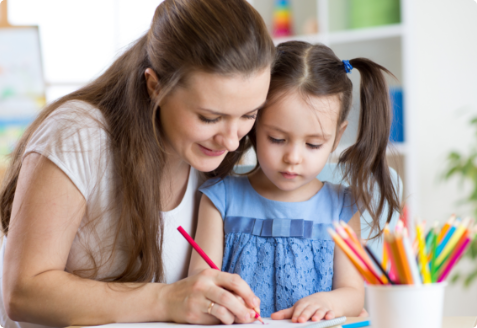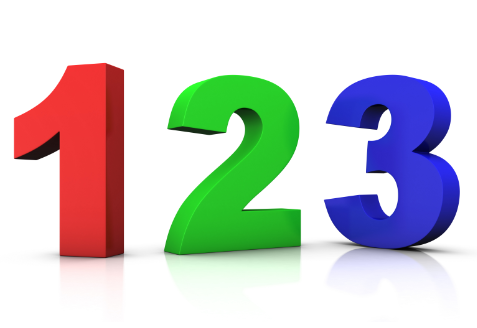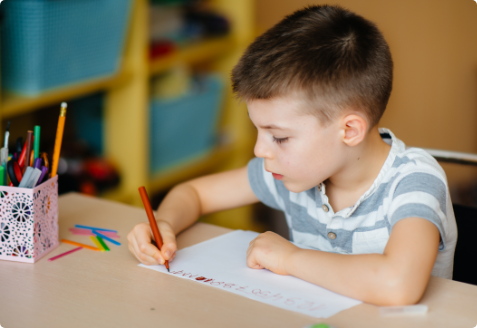Click on a concept below to try a sample question
Free, Printable Math
Worksheets for at-home practice

Download this informative guide to learn how to best support your second grader as they learn and master important second grade math concepts.
Download Now 25+ Free Practice Worksheet questionsClick on a concept below to try a sample question
A stated objective of Common Core State Standards (CCSS) is to standardize academic guidelines nationwide. In other words, what second graders learn in math in one state should be the same as what students of the same age are learning in another state. The curricula may vary between these two states, but the general concepts behind them are similar. This approach is intended to replace wildly differing guidelines among different states, thus eliminating (in theory) inconsistent test scores and other metrics that gauge student success.
An increased focus on math would seem to include a wider variety of topics and concepts being taught at every grade level, including second grade. However, CCSS actually calls for fewer topics at each grade level. The Common Core approach (which is clearly influenced by “Singapore Math”—an educational initiative that promotes mastery instead of memorization) goes against many state standards. Many states mandate a “mile-wide, inch-deep” curriculum in which children are taught so much in a relatively short time span, that they aren’t effectively becoming proficient in the concepts they truly need to understand to succeed at the next level. Hence, CCSS works to establish an incredibly thorough foundation not only for the math concepts in future grades, but also toward practical application for a lifetime.
For second grade, Common Core’s focus places a great emphasis in strengthening fluency in addition and subtraction. The idea that numbers are based on tens is expanded and reinforced, and units of measurement receive more attention. Ultimately, this focus will enable children to develop rigor in real-life situations by developing a base of conceptual understanding and procedural fluency.

Our worksheets for second grade focus on four essential concepts outlined by CCSS. These worksheets focus on building fluency with addition and subtraction, extending understanding of base-ten notation, using standard units of measure, and describing and analyzing shapes.
For many parents, second grade feels like the first year that school is really serious for their children. Many of the “cute” approaches to teaching math that might have been prevalent in kindergarten and first grade give way to an increased focus on critical concepts students will require in the next few years. Base 10 notation will give kids a better understanding of numbers up to 1,000—and they will need that understanding once operations eventually start using three-digit numbers. The simple addition and subtraction introduced in first grade not only will be re-emphasized, but also will be expanded to include two-digit numbers. And once addition becomes easier, students will be ready for the multiplication skills that will be taught in third grade. Here are the four critical areas that Common Core brings to second grade math:
 Base 10 Notation
Base 10 Notation
Base 10 is the idea that our number system is based on tens. Count to 10 and start again, only with the number in the tens spot increased by one. When the tens spot turns over from nine, you add a hundreds place, and so on. For second grade, students build upon this idea concept by learning about numbers up to 1,000, as well as understanding the concept of place value—that a number such as 629 is the same as 6 hundreds, 2 tens, and 9 ones.
 Addition and Subtraction
Addition and Subtraction
All the flash cards and other drilling to get addition and subtraction facts down in first grade pay off in second grade, as those concepts are applied to adding and subtracting numbers up to 100 and, eventually, 1,000. Students will learn multiple strategies to add and subtract bigger numbers, including the traditional place value method their parents were likely taught, and breaking apart addends on two two digit numbers (i.e., for 29+34, splitting the equation into 20+30=50 and 9+4=13, then adding 50+13 for the correct answer of 63).
 Standard Units of Measure
Standard Units of Measure
Centimeters and inches become the stars of the measuring world as students use rulers to gauge distance. Also taught is the concept that the smaller unit of measurement used, the more of that unit will be necessary to cover the length of something measured. Addition and subtraction of measurements are introduced, too.
 Shapes
Shapes
The big push into geometry won’t come until later grades, but understanding and drawing two dimensional and three-dimensional shapes are still emphasized with an eye toward the future.

From the four critical areas of focus discussed in the previous section, Common Core also further clarifies the skills second graders should know by the end of the school year. For example, the fluency requirement at this level is single digit sums and differences (i.e., basic addition and subtraction, committed to memory by the end of the year) and adding and subtracting within 100. The four topics presented here, taken directly from CCSS itself, include some specifics on what kids will be taught at in second grade.

 Operations and Algebraic Thinking
Operations and Algebraic Thinking
• Represent and solve problems using addition and subtraction. Students will add and subtract numbers up to 100 to solve word problems.
• Add and subtract within 20 The basic math facts introduced in first grade will reach a fluency level in second—kids can answer from memory addition and subtraction problems with an answer of 20 or less.
• Work with equal groups of objects to gain foundations for multiplication. As already mentioned, the addition learned in second grade will form a base for multiplication in third. Second graders will learn:
 Number Operations in Base 10
Number Operations in Base 10
• Understand place value. Students will be taught that a three-digit number can be broken down into a hundreds place, a tens place, and a ones place, and that a hundred is essentially a “bundle” of tens. Second graders will also learn to skip count by fives, tens, and hundreds to 1,000.
• Use place value understanding and properties of operations to add and subtract. The emphasis on base 10 will be applied to addition and subtraction with numbers up to 100. What parents might understand as “carrying” and “borrowing” will be introduced. Students will also learn how to mentally add or subtract by 10 and by 100.
• Use place value understanding and properties to add and subtract. While learning how to add a two-digit number to a one-digit number or 10, students will come to an understanding that they will add tens and tens together, then ones and ones, and sometimes have to compose a new ten to reach the answer (e.g., 36 + 42 = 30 + 40 = 70, 6 + 2 = 8. Second graders will also be taught how to mentally add 10 to a two-digit number and how to subtract multiples of 10 (within 90; e.g., 40 - 20 = 20).


 Measurement and Data
Measurement and Data
• Measure and estimate lengths in standard units. Students will measure objects using standard tools such as rulers, yard and meter sticks, and tape measurers. They will use two different methods of measurement (e.g., centimeters and inches) to measure the same object and estimate and compare the differences
• Relate addition and subtraction to length. Word problems will combine measurement with addition and subtraction concepts—in other words, a student might be asked how much shorter one object is than another.
• Work with time and money. Students will learn to tell time from analog and digital clock down to five-minute increments (e.g., 1:35 a.m., 2:20 p.m., and so on) and learn the concept of a.m. and p.m. Word problems will incorporate money, especially specific denominations (pennies, nickels, dimes, and quarters, and dollars).
• Represent and interpret data. Line plots, bar graphs, and picture graphs will be used to represent measurement data, and students will perform comparisons or simple arithmetic using information from a graph.
 Geometry
Geometry
• Reason with shapes and their attributes. The difference between defining attributes (a square has four sides) versus a non-defining attribute (that square is blue!) will be taught. Students will also compose two-dimensional and three-dimensional shapes and partition circles and rectangles into two or four equal shares, learning the terms halves, fourths and quarters along the way.

Some of parents’ trepidation with Common Core isn’t so much with the guidelines themselves, but with the testing now aligned with CCSS via local math curricula. Standardized testing was stressful for students and parents before; with the ongoing Common Core implementation, many families simply don’t know what to expect.
Fortunately, CCSS does not have to be that stressful, for you or your second grader. Here are some tips to help your children succeed with Common Core math:

 Be informed; be involved
Be informed; be involved
If Common Core concerns you, intrigues you, or confuses you, don’t hesitate to learn as much about it—in your child’s classroom, at your kids’ school, and on a national level. Talk with teachers, principals, and other parents. Seek advice on how you can help your kids, and yourself, navigate CCSS math. If you want to take further action, become involved with PTA or other organizations and committees that deal with your school’s curriculum. The more you know, the more, ultimately, you can help your child.
 Give them some real-world math
Give them some real-world math
A basic tenet of Common Core is to apply math principles to real-world situations. Why not start now? Give your child math problems when you are out and about—the store, in traffic, the park, and so on. For example, if you are at the grocery store and want to use the express lane, ask your student to figure out how many more items you can add to your cart and still stay under 20.
 Take time to learn what they are learning
Take time to learn what they are learning
You might look at a worksheet your child brings home and think, “This isn’t the math I’m used to.” Because Common Core emphasizes understanding the process of arriving at an answer, your child may be taught additional ways to fry a mathematical egg, so to speak. Instead of shunning these approaches, learn them for yourself. Once you comprehend these additional methods, you will be better able to help your child comprehend them as well.
 Encourage them to show their work
Encourage them to show their work
This suggestion can be read two ways. First, students will be encouraged to show how they arrived at an answer, especially within Common Core. Second, ask your children to show you their homework, particularly the challenging stuff. Explaining how a problem is solved is a basic CCSS tenet, so if your kids can be confident in explaining their work to you, they will carry that confidence into the classroom when the teacher asks for those same explanations.
 Seek more help if necessary
Seek more help if necessary
If your second grader is struggling with the new math standards, talk with his or her teacher first. You then might want to seek outside resources to help your child. Several online resources provide math help, including worksheets and sample tests that conform to Common Core standards. Tutoring might be an option you consider as well. Innovative iPad-based math programs have emerged that combine the personalized approach of a tutor with today’s technology. This revolutionary approach also may feature a curriculum based on Common Core, thus ensuring your child’s learning at home is aligned with what he or she is learning at school.
See up to a 90% Improvement in Math Scores Within 3 Months.
Start 7-Day Free Trial